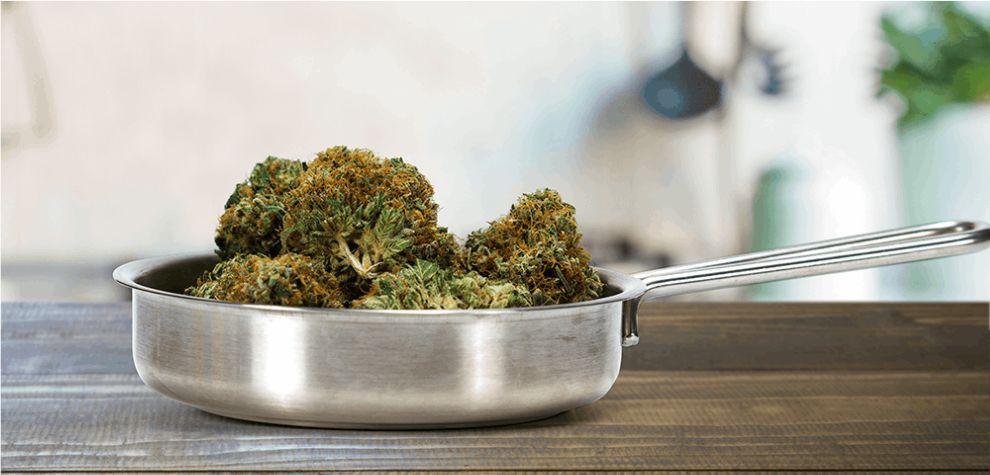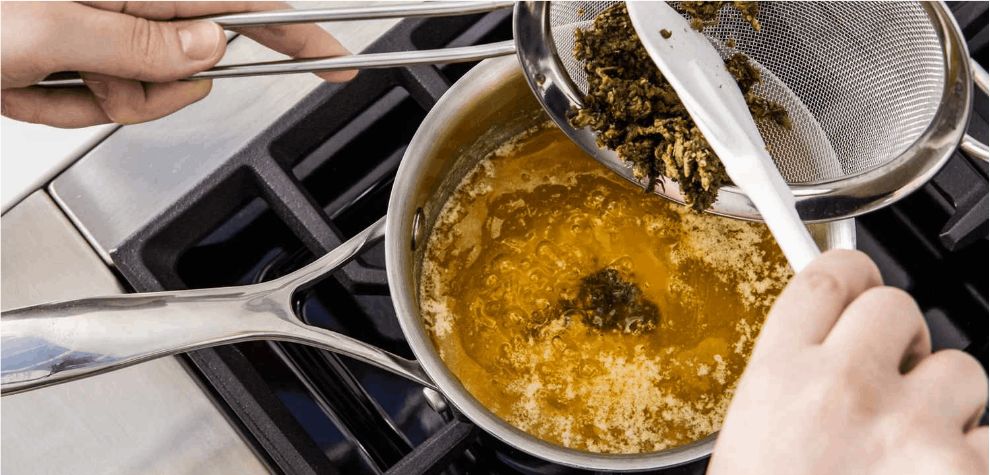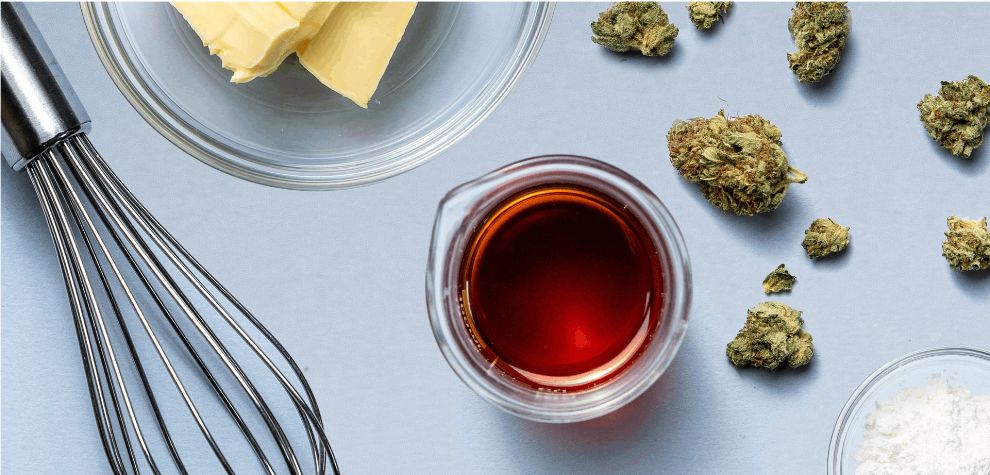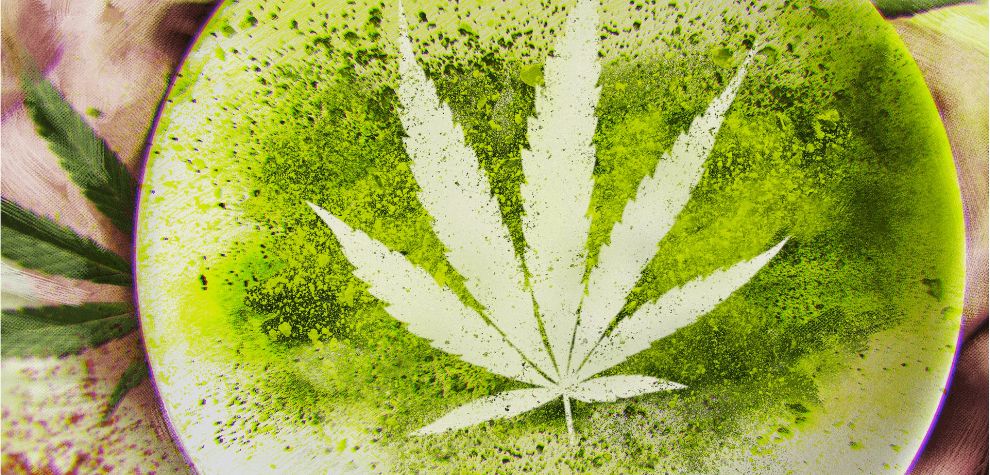Cooking With Cannabis: Recipes And Tips For Infusing Edibles

The Role Of Terpenes In Pairing Strains With Food When Cooking With Cannabis
Cooking with cannabis is more than making up an edible recipe with the goal of getting as high as possible. Cannabis cooking is an art that many ignore.
It’s easier to forget that some cannabis strains pair really well with some dishes, which can make the whole experience even more enjoyable.
Cannabis plants contain hundreds, if not thousands, of beneficial compounds, from the most popular cannabinoids such as tetrahydrocannabinol (THC), cannabidiol (CBD), terpenes such as myrcene and limonene, flavonoids and others.
All these compounds come together to provide the famous cannabis experience. What most people don’t know, cooking with cannabis reinforces that or takes it to another level.
Cannabis-infused foods allow you to show creativity and experiment with different aromas, flavours and recipes.
How often have you encountered a cannabis strain and thought it smells or tastes good enough to eat? Well, you can. Edibles have been around for centuries, with the earliest mention of weed-infused foods going as far back as 2000 B.C.
Cannabis and food always go together. That’s why even some strain names bring images of delicious pastries or candy to your mind.
In this article, we look at the art of pairing cannabis strains with foods to enhance flavours and experiences.

Cannabis Cooking: It’s All About The Terpenes
In the early days of cooking with cannabis, people didn’t pay much attention to how the weed compounds affected the flavours and aromas of the dishes.
Back then, the most viable way to consume weed in edibles was through baked cannabis products such as brownies.
But as we learn more about weed, we discover the compounds behind the effects we are so intrigued by. As a result, we can better understand how to pair cannabis strains with food more effectively to create an enjoyable experience.
Two things that attract us to both food and cannabis are the aroma and flavours. Have you ever wondered why strains have different scents and tastes?
It’s because of naturally occurring compounds known as terpenes. Strains have different terpene profiles, so no bud smells or tastes precisely like the other.
Different plants of the same strain can also have varying concentrations of terpenes, which may cause slight differences in taste and scent.
In the plant, terpenes are produced in the trichomes, with their primary purpose being to protect the plant against attacks from insects and herbivores, although they may also play a role in attracting pollinators.
But how can you pair cannabis strains with food?
When cooking with cannabis, you need to pay special attention to a strain’s terpene profile, as it will affect the dish the most.
With technological advancements in the industry, it’s possible to extract pure cannabinoids to infuse foods without impacting the flavour. However, full strains make the dish even better.

How Cannabis Terpenes Affect The Aroma And Flavour Of Your Dishes
Cannabis terpenes do more than give cannabis strains their flavour and aroma profiles.
They also work together with other cannabis compounds, such as cannabinoids, to provide what is known as the entourage effect.
This is a mechanism in which cannabis compounds work synergistically to provide more intense effects and benefits than one compound.
However, when cooking with cannabis, terpenes do more in addition to their regular benefits.
Terpenes can influence your dishes in a number of ways. They can even drastically change the taste of your food. Here are some of the ways terpenes impart food.
1. Aroma – Cannabis terpenes can enhance the aroma of your dish, making it more appealing.
For example, strains such as Lemon Haze have high concentrations of terpene limonene. Limonene is also found in citrus fruits, including lemons and oranges.
Adding this strain’s terpenes to your dishes will give it a citrusy aroma. Strains with high levels of myrcene will give your foods a tropical scent.
2. Provide new flavours – You may have a direction you want your dish to take in mind but have no idea how. This is where cannabis cooking comes in.
Some strains have unique flavours that may be hard to replicate with other ingredients. You can incorporate your favourite strains into your dishes to provide the flavour.
3. Mimic familiar flavours – Some cannabis terpenes provide similar flavours to other ingredients. For example, humulene is also found in hops used in brewing beer.
You can use strains such as Sour Diesel and GSC to mimic these flavours giving your dish a new twist.
4. Complement or balance your dish’s flavour – Cannabis cooking is not always about picking a strain that goes with your dish. You can also pick strains that complement or contrast the primary flavours of your food.
You can use terpenes just as you use herbs and spices to complement or balance other ingredients’ flavours.
For example, strains high in linalool, such as LA Confidential, may reduce the bitterness of certain ingredients.
While strains with high pinene concentrations, like Grape Ape, may complement dishes with earthy tastes.
5. Amplify and diversify flavours – Does your dish have a taste or aroma you’d like to double down on while adding a twist? Select a strain with a high terpene concentration that provides the flavour you are going for.
For example, strains high in pinene, such as Jack Herer and Blue Dream, may help amplify savoury notes in your dish.
On the other hand, if you want to add a spicy or peppery note, strains such as Lemon Zest, Congolese and Dolato will come in handy.

Using Terpenes To Pair Cannabis Strains With Food
To pair a strain with a dish when cooking with cannabis, all you have to do is research your favourite bud, find out how it smells and tastes, and the dominant terpene.
You’ll also want to find other plants with the dominant terpene and try to work out the flavour and scent from there.
Below are three common terpenes, the strains that they are dominant in and delicious pairing ideas for each.
1. Limonene – This terpene has a citrusy aroma and flavour and can help add bright notes to savoury dishes.
It is also found in citrus fruits, including lemons, lime and oranges. Strains high in this terpene are also great for desserts.
High-limonene strains include Super Lemon Haze, Do-si-dos, Banana OG, Wedding Cake, and Sour Diesel.
These citrusy strains can pair with fish, poultry, and vegetables. They also pair well with fruits, cookies, cakes, etc.
2. Myrcene – This is the most abundant terpene in cannabis. It provides herbal, earthy, spicy and musky flavours with a hint of citrus.
This terpene is also found in thyme, hops, lemon grass, and mangoes. This strain is mostly found in indica strains and tends to have a sedative effect.
Myrcene heavy strains to consider when cooking with cannabis include Granddaddy Purple, Blue Dream, Purple Urkle, and White Widow.
These cannabis strains pair well with cheeses and meat dishes. They add a sweet musky flavour, depth, and richness to the overall flavour.
3. Caryophyllene – Caryophyllene is a unique terpene. As far as we know, it’s the only terpene found to exert effects by interacting with the cannabinoid receptors of the endocannabinoid system ECS.
Caryophyllene has a spicy, peppery flavour reminiscent of cinnamon, black pepper, cloves and herbs like basil and oregano.
Caryophyllene heavy strains include Sour Diesel, Bubba Kush, Super Silver Haze, and Death Star. Caryophyllene-heavy strains pair great with meats and salads.

Tips For Enhancing The Overall Dining Experience With Cannabis Strains
1. Plan in advance
When cooking with cannabis, plan the ingredients ahead of time. This will give you time to seek out the most suitable cannabis strains to pair your dishes with.
When selecting the cannabis strain, think of the strongest flavour element in the food and decide what you want to do with it.
2. Use your nose
While it’s prudent to research how a strain smells and tastes, ensure you smell it before using it to get a full handle. This will help you decide what ingredients to pair it with and how much you should use.
3. Start small and taste test
You don’t want to overpower your dish. It is advisable to start with a small amount and taste test as you go.
This will ensure you don’t use too little of your cannabis to have an effect or use too much and overpower the other ingredients.
Also, keep in mind the amount of THC you are using to avoid overwhelming effects.
4. Consider flavour profiles
Consider the distinct flavour profile of the cannabis strains and how they might complement or contrast with the flavours in your dish.
Some flavours go well with some terpenes, for example, citrusy strains pair well with seafood and meat dishes.
If you have a delicately flavoured dish, you may have to opt for subtle strains.
5. Be mindful of the heat
Keep in mind that some terpenes and cannabinoids can be destroyed by heat when cooking with cannabis.
So, find the best way to infuse cannabis into the dish, depending on the recipe, while preserving as many terpenes and cannabinoids as possible.

Experiment: You Cannot Mess Up
Don’t be afraid to experiment when cooking with cannabis. It’s almost impossible to mess up. Try different combinations, and you might discover something amazing.
However, remember that for the best results when cannabis cooking, you need high-quality weed.
MMJ Express is Canada’s leading online dispensary known for offering premium quality weed at the lowest prices in the market.
If you are looking to buy weed online, check out our extensive selection of cannabis flower, concentrates, edibles and more. Order weed online in Canada today!
